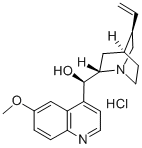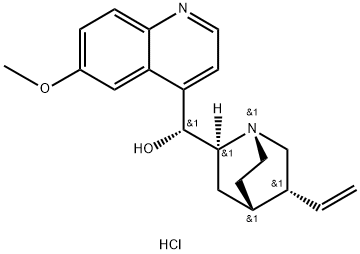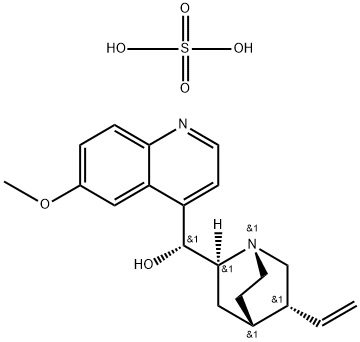A1046850
Quininehydrochloride , 98% , 130-89-2
CAS NO.:130-89-2
Empirical Formula: C20H25ClN2O2
Molecular Weight: 360.88
MDL number: MFCD00078498
EINECS: 205-001-1
| Pack Size | Price | Stock | Quantity |
| 5g | RMB63.20 | In Stock |
|
| 25g | RMB215.20 | In Stock |
|
| 100g | RMB775.20 | In Stock |
|
| others | Enquire |
Update time: 2022-07-08
PRODUCT Properties
| Melting point: | 158-160 C |
| Density | 1.1206 (rough estimate) |
| refractive index | 1.5400 (estimate) |
| FEMA | 2976 | QUININE HYDROCHLORIDE |
| storage temp. | under inert gas (nitrogen or Argon) at 2-8°C |
| solubility | DMSO (Slightly), Ethanol (1g/1ml), glycerol(1g/7ml), chloroform(1g/1ml) |
| form | Solid |
| color | White |
| Water Solubility | 549.7mg/L(25 ºC) |
| InChIKey | LBSFSRMTJJPTCW-QJLYHTAINA-N |
| SMILES | C12C=C(C=CC=1N=CC=C2[C@@H](O)[C@]1([H])C[C@]2([H])CCN1C[C@@H]2C=C)OC.Cl |&1:10,12,15,21,r| |
| LogP | 3.496 (est) |
| EPA Substance Registry System | Cinchonan-9-ol, 6'-methoxy-, hydrochloride (1:1), (8.alpha.,9R)- (130-89-2) |
Description and Uses
Quinine Hydrochloride is used as an antimalarial drug, and is the active ingredient in extracts of the cinchona that have been used for that purpose since before 1633. Quinine is also a mild antipyretic and analgesic and has been used in common cold preparations for that purpose. It was used commonly and as a bitter and flavoring agent, and is still useful for the treatment of babesiosis. Quinine is also useful in some muscular disorders, especially nocturnal leg cramps and myotonia congenita, because of its direct effects on muscle membrane and sodium channels. The mechanisms of its antimalarial effects are not well understood.
Safety
| Symbol(GHS) |  GHS07 |
| Signal word | Warning |
| Hazard statements | H302-H319 |
| Precautionary statements | P305+P351+P338 |
| Hazard Codes | Xi |
| Risk Statements | 36/37/38 |
| Safety Statements | 26-36-24/25 |
| RIDADR | 1544 |
| HazardClass | 6.1(b) |
| PackingGroup | III |
| HS Code | 29392000 |
| Toxicity | cat,LDLo,intravenous,80mg/kg (80mg/kg),Journal of Pharmacology and Experimental Therapeutics. Vol. 30, Pg. 327, 1927. |




